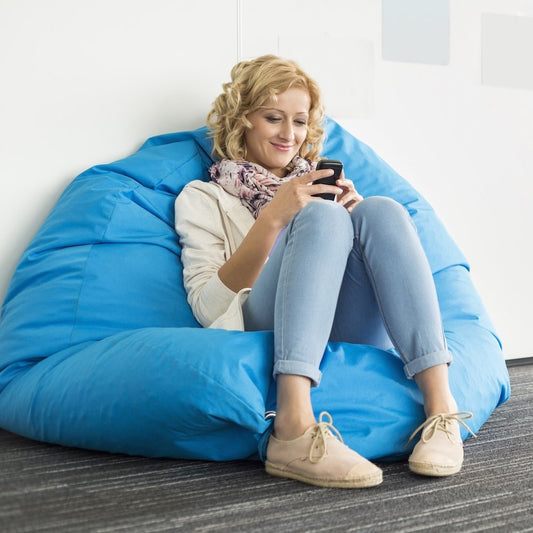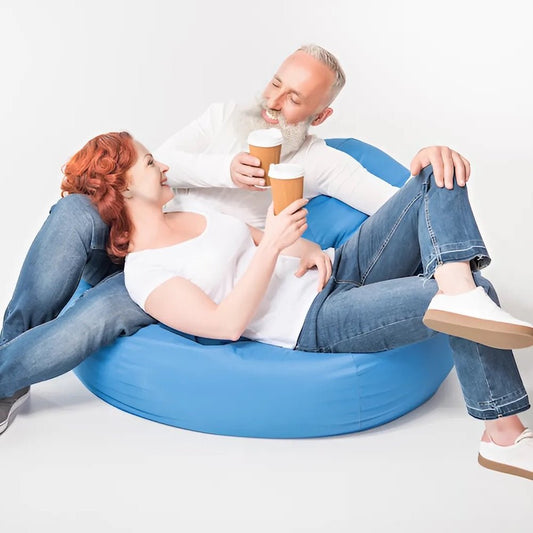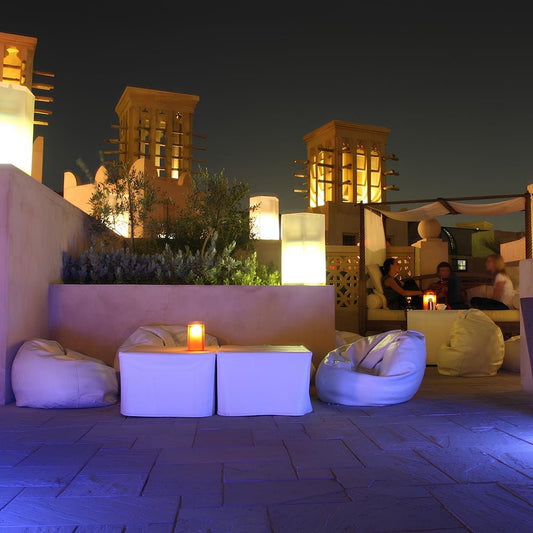There's nothing worse than buying brand new outdoor furniture, only to find that after a couple of months, the material has faded in the sun. Now it is a shadow of its former self. However, despite the obvious threats ultraviolet (UV) radiation poses, many manufacturers still churn out outdoor furniture without adequate sun protection. As a consequence, materials look bleached, often after just a few weeks of use. Read on to learn how to stop fabric from fading in the sun!
In this post, we take a look at how you can stop fabrics from fading in sunlight. We explore what sun-resistant fabric is, what UV light does to regular materials and some of our favourite methods for protecting your investment. We do this by making a bean bag chair Australia will love!
What Is Sun-Resistant Fabric?
Sun-resistant fabric - also sometimes called UV-resistant fabric is a type of material that can survive in direct sunlight without fading. Manufacturers use a range of processes to prevent ultraviolet radiation from damaging materials so that they survive longer.
Manufacturers rate the UV resistance of fabrics according to their Ultraviolet Protection Factor (UPF). 50 is a high UPF rating and indicates that a fabric blocks 98 per cent of the sun's rays. Anything above 50 is considered very good by most international bodies.
Why Does UV Damage Fabrics?
UV is a type of high-frequency light that is not visible to the naked eye, which exists beyond violet (the highest frequency we can see). Incoming solar energy is approximately 10 per cent UV, with the rest being visible light and X-rays.
UV is dangerous because, unlike visible light, it contains so much energy that it can penetrate materials and destroy the chemical bonds that hold them together at the molecular level. For the same reason, it can bump particles off chains of DNA in our skin, causing mutations that lead to cancer.
When UV interacts with the colour molecules in a fabric, it induces a chemical reaction that causes them to break down. Over time, this shows up as fading.
Primarily, UV damages the organic compounds in dyes that give fabrics their colour. However, after protracted sun exposure, it can also damage material fibres themselves, breaking them down too.
How Do Manufacturers Make Fabrics UV-Resistant?
Manufacturers of outside bean bag chairs use several methods to make fabrics more UV-resistant including additives, absorbers, blockers, stabilisers, or furnishing UV resistance into the fabric itself.
Additives refer to certain molecules that manufacturers mix into the polymer before extrusion. These fuse with the material, increasing its UV resistance by either making it better able to reflect or absorb UV rays. Due to the chemical bonds, they form with the underlying substrate, they cannot wash out.
Furnishing UV protection into the fabric itself is another common method. Manufacturers do this by dying it a dark colour, or further impregnating it with inks. Darker tones tend to absorb UV rays better than lighter ones.
Blockers include titanium oxide or black carbon-based pigments. These effectively prevent UV light from interacting with structural components of the fabric, such as polyester plastic polymers.
Absorbers work by transforming solar energy into heat. Organic varieties include benzotriazoles and benzophenones. Inorganic absorbers include cerium oxide, nano-scale zinc oxide, and, in some cases, titanium dioxide.
Stabilisers
Stabilisers are another class of chemicals that work via a slightly different mode of action to protect against UV radiation. Instead of blocking the UV from interacting with polymers or colour compounds in the fabric, they absorb the dangerous free radicals byproducts of those interactions. Trapping high-energy particles prevent the subsequent degradation of intermolecular bonds.
Sometimes, you will see stabilisers referred to as 'scavengers' because of how they collect wayward free radicals and bring them under control before they can do any damage. The most common scavengers are amine light stabilisers, but there are others.
In some cases, the yarn and weave themselves can confer UV resistance. For example, synthetic fibres, such as acrylic and nylon, are naturally resistant to sunlight, only fading after many years of sun exposure. Tighter weaves that pack individual fibres closer together can have a similar effect by preventing UV light from penetrating the material further.
The term 'sunproof' fabric is a bit of a misnomer. No fabrics can withstand UV rays indefinitely, not even those produced by NASA. However, buyers should expect their UV-resistant furniture to survive for many years outside. Compared to conventional counterparts, their performance is considerably better.
How To Prevent Your Fabrics From Fading In Direct Sunlight
Given that direct sunlight can seriously damage fabrics, you probably want to know what you can do to protect your upholstered outdoor furniture. Many items start out looking vibrant and new, only to fade over time.
Protect Your Furniture Year-Round
The first step is to take steps to protect your furniture year-round. Many people believe that UV light is only a problem in the summer months when the weather is at its hottest. However, the sun emits ultraviolet radiation continuously, even during the winter. Therefore, it's important to protect furniture year-round, even if temperatures are low.
The same applies to grey days. Even if the sky is overcast, UV light can still get through and damage the fabric.
Snow is perhaps the worst culprit (and one of the reasons skiers slather themselves in sun lotion before hitting the pistes). It reflects UV light in all directions, giving it another opportunity to interact with dye molecules in fabrics and break them down.
Use Covers
Another popular technique is to use covers that take the brunt of the sun's wrath. Today, many upmarket outdoor furniture options come with stylish protective covers that prevent damage from sunlight. Many offer 100 per cent UV protection.
Because covers are made of fabric, they work in much the same way as conventional UV-resistant upholstery. Manufacturers make them from fibres that offer inherent UV protection, such as nylon and acrylic. And because style and weight are not so much of a consideration, they are often thick, preventing virtually all light from getting through.
Of course, UV covers can be a little hit or miss. Some are great and contour to the shape of your furniture perfectly, while others look less neat and tidy. You'll take them off your furniture when it is in use or you are entertaining guests, but the rest of the time, they will remain in place, so looks matter.
Don’t Shop For Outdoor Furniture Blindly
As indicated above, not all outdoor furniture offers the same degree of UV resistance. Some manufacturers invest more in the technology than others.
In many cases, applying UV protection has no impact on the comfort of the fabric at all. Additives and chemicals simply blend with the underlying fibres before extrusion, developing protection from the inside out that won't wash out in the rain.
However, as with any additional process, it comes with a price tag, one that some vendors don't want to pay. Therefore, it is wise to always check the UV properties of any fabric you intend to keep outside before buying.
Start by doing your own research. Check the materials used to construct the upholstery. If the label says nylon or acrylic, you're safe the item will survive outdoors without fading long-term. However, if the material is more conventional, say cotton or polyester, then you will need to check if it has been treated.
You can also eye-ball fabrics to get a sense of whether they will survive in direct sunlight. The darker the colour and tighter the weave, the more sun resistance the material will have.
Of course, you don't have to design your entire home around UV resistance. But choosing a darker theme can make the task easier. Alternatively, you can opt for highly-reflective pure white as this cannot fade.
Add Shade
If the idea of covering up your outdoor furniture every time you stop using it doesn't appeal to you, you might want to investigate shade options. Here, you have several choices.
One is to erect a pergola. These look natural, work well with outdoor rooms and are easy to put up. The furniture won't have 100 per cent sun protection throughout the day, but the amount of solar energy getting through will be considerably less than if you leave them in the open air.
Another option is to use an awning. Depending on the angle of the sun, this may provide 100 per cent protection for large chunks of the day, particularly at midday when the sun is overhead and UV radiation is at its most intense.
For those who enjoy sunlight but want to protect themselves and their furniture against UV, transparent solar umbrellas are another option. They let natural light penetrate but block unwanted UV.
If you have a conservatory and you are worried about light pouring through windows and fading segments of exposed furniture, you can invest in UV film. Products are affordable and can block up to 99 per cent of UV rays.
Rotate Your Furniture
Rotating your furniture won't protect it against sunlight-induced damage, but it can slow the rate of fading when done correctly. For instance, if the edge of an outdoor sofa sticks out from underneath your pergola and catches the midday sun, you may want to move it around every couple of weeks to expose a new part of it. Rotating furniture in this way makes UV damage more gradual and even.
You can do the same for cushions, too. Just flip them over periodically if you leave them out in the sun to get the same rate of fading on both front and back.
Can You Protect Fabrics Against UV After Buying Them?

If you find some outdoor furniture that you love but doesn't have UV protection, then don't despair. There are now aftermarket products that let you apply sun resistance yourself.
UV fabric protection spray treatment is scientifically formulated to provide exceptional UVA and UVB protection - the two types of ultraviolet light. Like sunscreen, it acts as a kind of forcefield around your fabrics, stopping UV light from damaging them, even in the harshest conditions.
Most solutions rely on depletable chemicals that disperse energy from incoming UV rays. When a photon hits the fabric, it interacts with molecules in the UV spray instead of those that give the upholstery its colour. These then take the energy out of the light, rendering it harmless, thereby protecting the furniture. Products are suitable for a variety of exterior upholstery, including furniture, grill covers, flags, tarps, boat covers, auto covers, spa covers, and more.
What Are The Best Outdoor Fabrics For Resisting Sunlight?
While you can make virtually any fabric sun-resistant, some are better than others.
Solution-Dyed Polyester
Solution-dyed polyester is a good outdoor option for several reasons. It's affordable, abrasion-resistant, and prevents the growth of mould and mildew. What's more, solution-dyed varieties have exceptional UVA and UVB resistance, making them ideal for outdoor use.
Manufacturers put solution-dyed polyester through a wet-spinning process that injects the colour pigment into the structure of the fibre. This makes it considerably more difficult for UV rays to cause fading. Instead of easy pickings on the surface of the fabric, light has to penetrate deeper and attack colour molecules embedded in the body of the weave. Even if surface discolouration does occur, colour molecules deeper down enable the fabric to maintain its original hue.
Nylon
Nylon, like polyester, is made of plastic. However, it is not identical. Nylon weaves tend to offer superior abrasion resistance, which is why you find this fabric so often in outdoor settings.
Nylon, like other fabrics, is susceptible to UV degradation. However, there are significant differences between various types of nylon.
For example, nylon 6 has higher UV resistance than nylon 6/6. Nylon dyes fade over time when exposed to sunlight, while nylon itself degrades via the action of UV-induced free radicals acting on its intermolecular bonds.
Despite incurring some damage, particularly in the 290-315 nm spectra range, nylon is still an exceptionally UV-resistant fabric. Those looking for upholstery for outdoor furniture should consider either Nylon 6 or Nylon 12.
For enhanced UV resistance, check product labels for blockers, absorbers, and stabilisers. Nylons can contain all three.
Ripstop
Ripstop is a composite fabric made from a polyester-nylon blend. In this case, the material gains UV resistance from the weaving technique itself. The density of the weave offers a degree of protection against UV light.
As the name implies, ripstop fabrics cease ripping once a tear begins. Therefore, manufacturers use it in many outdoor applications, including garden furniture. Ripstop is an ideal material for bean bag covers, tents, and even sleeping bags.
Solution-Dyed Acrylic
Like solution-dyed polyester, solution-dyed acrylic uses a wet-spinning process to imbue individual fibres with colour particles. Manufacturers inject ink particles directly into the polymers, preventing the dye from fading when exposed to UV.
Many outdoor acrylic fabrics also come with a UV-protective finish. This additional step prevents sunlight from damaging the fibres directly.
Can You Use Scotchgard To Protect Outdoor Fabrics?
You can use Scotchgard to protect outdoor fabrics, including patio furniture upholstery. However, before applying the spray, you should always check with the manufacturer. Scotchgard is safe for use with nylon, canvas, polyester and leather, but may interact with other fibres or chemicals in the material.
If you can't get any information from the manufacturer, try applying Scotchgard to a small, inconspicuous patch first to see what happens. Check back the next day to see if the fabric remains colour-fast.
What Materials Qualify As Having UV Protection?
To qualify as ultraviolet protective fabric, materials must have a UV protection factor (UPF) of at least 15. ASTM International and many national bodies that rate the UV protection offered by various materials adhere to the following general classifications:
- 15-24: 'Good'
- 25-39: 'Very good'
- 40+: 'Excellent'
How much protection is enough? That depends on your location. If you're in a temperate region (outside of the tropics, but not in polar regions), then a UPF over 20 should be sufficient to protect your furniture. However, if you are in the tropics where the sun is most intense, particularly during the middle of the day, then you will want a UPF rating between 30 and 40 to be on the safe side.
Conclusion
No matter what measures you put in place (aside from protecting fabrics under shelter), they will eventually fade. Preventing all UV light damage is virtually impossible because of the nanoscales involved. However, there are many ways to slow down this process. Perhaps the most convenient is to choose outdoor furniture made of sun-resistant fabrics. Manufacturers will often advertise the UV rating on the product on the label if they have included additives or impregnated fibres with UV-protective materials. Another option is to simply move furniture so that it spends less time in the sun, or protect it with covers. Every method has pros and cons associated with it. The most inherently UV-resistant fabrics are synthetics, such as nylon and polyester. However, these may not offer as much comfort as natural materials, like wool and cotton.




